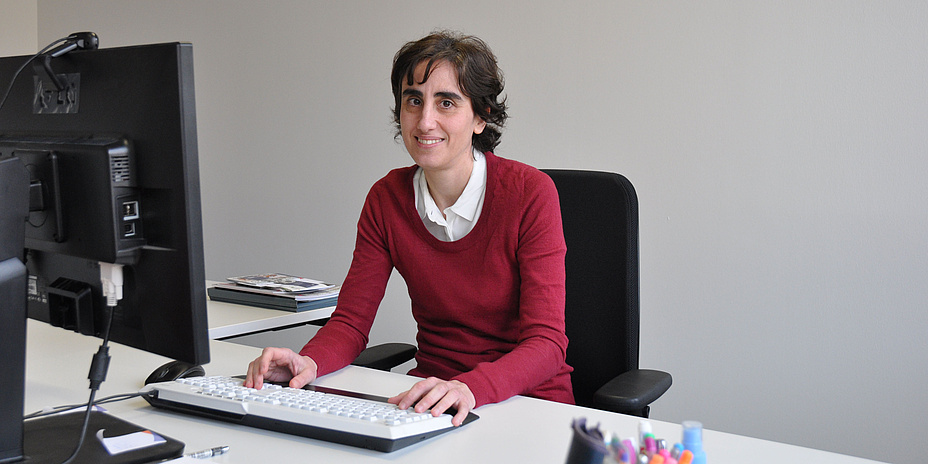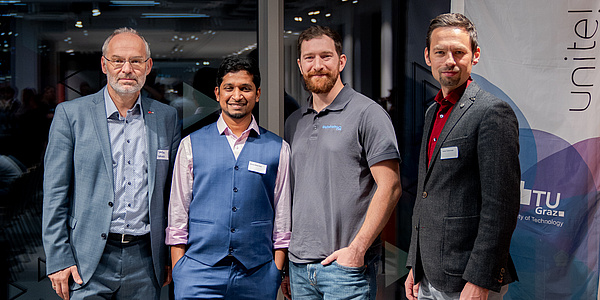Researcher of patterns in the large text of DNA

News+Stories: You have recently been appointed head of the newly founded Institute of Biomedical Informatics at Graz University of Technology (TU Graz) and conduct research in the field of genomics. What is that exactly?
Leila Taher: My topic is actually called "functional genomics" or "regulatory genomics" and is related to the genome. Children inherit the genome from their parents. It is basically what defines us. Mendel studied heredity about one hundred and fifty years ago, but in plants. He discovered the effect of the genes, even though he knew nothing about the genome. Genes are sections of the genome that need to be decoded by the cells to form proteins. Today, we know that different species are very similar at the gene level. As humans, we think that we have little in common with mice or flies, but the truth is that our genes differ little from theirs. What makes the difference is which genes are active, when, and how active they are. That's what interests me as a researcher. I am trying to understand the mechanisms by which proteins are produced and how many of them there are in the cells of our body.
As humans, we think that we have little in common with mice or flies, but the truth is that our genes differ little from theirs.
How does informatics come into play?
Leila Taher: This has little to do with classical computer science. As a genomic scientist, I study DNA. It’s a very special molecule, composed of units which repeat themselves. You can read DNA like a text. It’s a strange text consisting of three billion letters – a very boring text in the sense of the alphabet because it only contains the four letters A, C, G and T. These are the building blocks adenine, thymine, guanine and cytosine. In bioinformatics, we want to read the DNA text and know what sections in the text mean and what their function is for the structure of the proteins. And this is where computer science comes in. As a bioinformatician I try to recognize patterns in the large "DNA text". We use the Artificial Intelligence (AI) method for this, and we’ve been using it for a long time – long before anyone talked about it (laughs).
In bioinformatics, we want to read the DNA text and know what sections in the text mean and what their function is for the structure of the proteins. And this is where computer science comes in. As a bioinformatician I try to recognize patterns in the large "DNA text". We use the Artificial Intelligence (AI) method for this, and we’ve been using it for a long time – long before anyone talked about it.
So in other words, bioinformaticians look for repetitive combinations in the genetic information?
Leila Taher: Yes, since DNA consists of only four "letters", it is a matter of combination and context. This is how the meaning comes about. We often compare genomes with each other. Genomes of different people differ little. But if I assume that many people who get sick have a certain alteration in the genome that leads to the disease, I can systematically search for such sites. This can really only be done with a computer. To do this, you compare people – for example, people who are healthy with people who all have a particular disease – to find the difference. However, there is usually not only one difference, there are many differences – and most of them do not mean anything for the disease in question. They can have no meaning or a completely different meaning.
Did you come to bioinformatics because you wanted to research diseases?
Leila Taher: When I started, I thought about studying medicine because – like many young people – I wanted to cure diseases. But I was probably too introverted for dealing with patients. In addition, what really interests me are the mechanisms behind a disease. Doctors are trained to diagnose and treat diseases. The mechanisms by which diseases develop are almost exclusively the concern of doctors working in research. On the advice of my father, who is a chemist, I therefore began to study biotechnology rather than medicine. This of course includes mathematics, chemistry, physics and biology. Biology was too descriptive for me; I wanted to find a formula that would explain everything. This is in principle what is now called quantitative biology, which is a very mathematical approach. At the time, this field did not exist and I studied mathematics parallel to biotechnology until I obtained my bachelor's degree. This mixture of biology and mathematics – that's my area.
This mixture of biology and mathematics – that's my area.
So this is how you went from wanting to be a doctor to wanting to be a bioinformatician. What fascinates you most about it today?
Leila Taher: That we know so little about it; that there are so many challenges, so many unanswered questions. I just want to know. Of course, research today is much further ahead than it was about 20 years ago when the human genome was decoded. Nevertheless, we actually know very little, even though in the meantime not only one genome has been sequenced, i.e. read, but thousands of genomes – of humans, but also of other species. From a bioinformatics point of view, this is great. We can now compare them in order to identify and understand differences.
Has being a woman played a role in your career as a scientist?
Leila Taher: (Laughs) No. My mother is a scientist. For me it was always quite normal. During my studies, many female teachers also taught me. I never thought it could be a problem. Most women in Argentina work. As in France, for example, children normally go to a nursery. When I arrived in Germany, I noticed that career planning is different here. Many women stay longer at home with their children. This makes planning a career more difficult.
What is a perfect day for you?
It is a wonderful feeling when I can pass on some of my own enthusiasm. And then I feel that I’ve achieved something – and this turns a normal day into a perfect day.
Leila Taher: I prefer working on a project all day long – something which doesn't happen very often because there are many other things to be done. But it can also be very satisfying when I give a lecture and the students are engaged and active. It is a wonderful feeling when I can pass on some of my own enthusiasm. And then I feel that I’ve achieved something – and this turns a normal day into a perfect day.
The Argentinean Leila Taher studied biotechnology and mathematics at the Universidad Nacional del Litoral. She completed her doctorate in bioinformatics and in 2006 she wrote her doctoral thesis on computer-aided prediction of splice sites in the human genome at the University of Bielefeld, Germany. Afterwards she worked as a postdoctoral fellow at the Fundación Miguel Lillo/CONICET in Argentina, as a visiting fellow at the National Institutes of Health in the USA, and as junior research group leader of the Gene Regulation Group at the University Medical School in Rostock, Germany.
Since 2015, Leila Taher has been a junior professor in bioinformatics at the Department of Biology of the Friedrich-Alexander University of Erlangen-Nuremberg. In 2016, she habilitated in medical informatics and was granted the right to teach as a full professor at the University Medical School in Rostock.
Kontakt
Leila TAHER
Dr.rer.nat.habil.
Institute of Biomedical Informatics
Stremayrgasse 16/I
8010 Graz, Austria
leila.taher@tugraz.at
Phone: +43 316 873 5380




